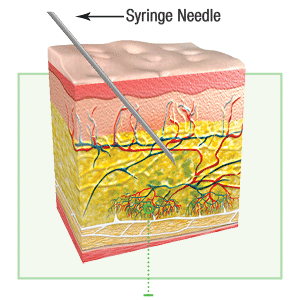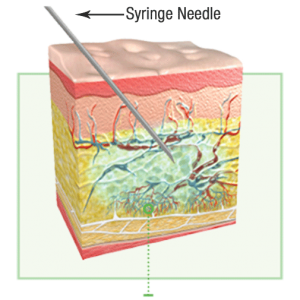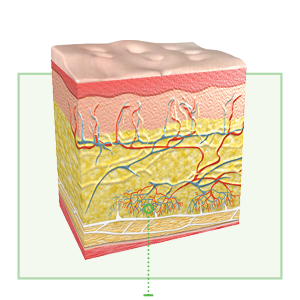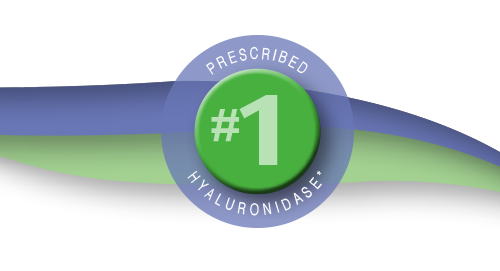 Hylenex recombinant is administered in the subcutaneous skin layer. Hyaluronidases should not be injected into or around an infected or acutely inflamed area because of the danger of spreading a localized infection.
Hylenex recombinant is administered in the subcutaneous skin layer. Hyaluronidases should not be injected into or around an infected or acutely inflamed area because of the danger of spreading a localized infection. Hylenex recombinant temporarily breaks down the hyaluronan barrier to open access to the lymphatic and capillary vessels, allowing injected drugs and fluids to be absorbed quickly into systemic circulation.1
Hylenex recombinant temporarily breaks down the hyaluronan barrier to open access to the lymphatic and capillary vessels, allowing injected drugs and fluids to be absorbed quickly into systemic circulation.1 With each injection of Hylenex recombinant, access to the subcutaneous space is opened.
With each injection of Hylenex recombinant, access to the subcutaneous space is opened. The hyaluronan rebuilds naturally, and the barrier is completely restored within 48 hours. Knowledge of the mechanisms involved in the disappearance of injected hyaluronidase is limited. The most frequently reported adverse reactions have been mild local injection site reactions such as erythema and pain. Hyaluronidase has been reported to enhance the adverse reactions associated with co-administered drug products.
The hyaluronan rebuilds naturally, and the barrier is completely restored within 48 hours. Knowledge of the mechanisms involved in the disappearance of injected hyaluronidase is limited. The most frequently reported adverse reactions have been mild local injection site reactions such as erythema and pain. Hyaluronidase has been reported to enhance the adverse reactions associated with co-administered drug products.Indication:
Hylenex® recombinant (hyaluronidase human injection) is an endoglycosidase indicated as an adjuvant to increase the dispersion and absorption of other injected drugs.
Important Safety Information:
Contraindications
Hylenex recombinant is contraindicated in patients with known hypersensitivity to hyaluronidase or any of the excipients in Hylenex recombinant. Discontinue Hylenex recombinant if sensitization occurs.
Warnings and Precautions
Spread of Localized Infection: Hyaluronidase should not be injected into or around an infected or acutely inflamed area because of the danger of spreading a localized infection.
Ocular Damage: Hyaluronidase should not be applied directly to the cornea. It is not for topical use.
Adverse Reactions
Allergic reactions have been reported in less than 0.1% of patients receiving hyaluronidase. Anaphylactic-like reactions following retrobulbar block or intravenous injections have occurred, rarely.
The most frequently reported adverse reactions have been mild local injection site reactions, such as erythema and pain. Hyaluronidase has been reported to enhance the adverse reactions associated with co-administered drug products.
Drug Interactions
Furosemide, the benzodiazepines, products containing sodium metabisulfite (e.g. in local anesthetic products containing epinephrine) and phenytoin are incompatible with hyaluronidase.
Hyaluronidase should not be used to enhance the dispersion and absorption of dopamine and/or alpha agonist drugs.
When used with local anesthetics, hyaluronidase hastens the onset of analgesia and shortens its duration of effect, and increases the incidence of systemic reactions.
Patients receiving large doses of salicylates, cortisone, ACTH, estrogens or antihistamines may require larger amounts of hyaluronidase for equivalent dispersing effect.
Available by prescription only.
You may report an adverse event related to Hylenex recombinant by calling 1-877-877-1679. If you prefer, you may contact the FDA directly. Visit www.fda.gov/medwatch, or call 1-800-FDA-1088.
Please see the Full Prescribing Information.
Reference:
1. Bookbinder LH, Hofer A, Haller MF, et al. A recombinant human enzyme for enhanced interstitial transport of therapeutics. J Control Release. 2006;114:230-241.
Clicking this link will open a new tab outside of hylenex.com. Halozyme Therapeutics is not responsible for the information provided on the linked website, including any information that may be about Halozyme Therapeutics or its products. This link is not intended to state or imply that Halozyme Therapeutics has prepared, sponsored, approved, monitored, or endorsed any information on the linked website or that the linked website is legally authorized to use any trade name, trademark, logo, seal, or copyrighted information that belongs to Halozyme Therapeutics.
OK CANCEL




